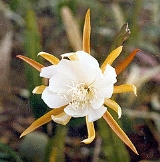
Epiphyllum laui
Encyclopedia
Epiphyllum laui is a cactus
species
native to Mexico
. The species is grown as an ornamental. Unfortunately most stock in cultivation seems to be infected with virus.
Flowers 15–16 cm long, 14–16 cm wide, opening in the evening and remain fully expanded for two days, funnelform; pericarpel inconspicuous, ca 2 cm long; olive green, tinged pinkish; bracteoles subtening spare areolar wool and 1-3 thin yellowish spines; the reminder of pericarpel 9 cm long, yellowish olive, tinged pinkish or orange-yellow by light; bracteoles 1-2, without areolar wool; outer tepals recurving to nearly rotate or ascending, attached within 1,5 cm of receptacle, linear-oblanceolate, rather abruptly acute, 7–9 cm long, 5–10 mm wide, outermost reddish orange or reddish yellow, innermost pure yellow; inner tepals 11, forming a campanulate cluster, obovate-oblong, abruptly aristate, 6–7 cm long, 20–22 mm wide, outermost white tinged yellow, innermost pure white; stamens 4 cm long, forming a throat-circle at receptacle apex, cream; anthers light yellow; style 12,5 cm long, lobes 8, expanding and recurving, cream.
Fruit oblong, (4-5) 6 (-8) cm long, 2-3 (3-4) cm thick at middle, carmine red, flesh white, pink when fully ripe. Seeds ovoid-reniform, 2 mm long, 1 mm thick, black.
Cactus
A cactus is a member of the plant family Cactaceae. Their distinctive appearance is a result of adaptations to conserve water in dry and/or hot environments. In most species, the stem has evolved to become photosynthetic and succulent, while the leaves have evolved into spines...
species
Species
In biology, a species is one of the basic units of biological classification and a taxonomic rank. A species is often defined as a group of organisms capable of interbreeding and producing fertile offspring. While in many cases this definition is adequate, more precise or differing measures are...
native to Mexico
Mexico
The United Mexican States , commonly known as Mexico , is a federal constitutional republic in North America. It is bordered on the north by the United States; on the south and west by the Pacific Ocean; on the southeast by Guatemala, Belize, and the Caribbean Sea; and on the east by the Gulf of...
. The species is grown as an ornamental. Unfortunately most stock in cultivation seems to be infected with virus.
History
Even though this plant was discovered in 1975, it was not described until 1990 as it failed to flower at the Huntington Botanical Garden. However, it flowered profusely for Alfred Lau in Mexico, as in several European collections, so Myron Kimnach knew that the plant represented a new species. In 1989, is finally flowered at Huntington and Mr. Kimnach could prepare a scientific description and name this beautiful plant.Origin and habitat
Mexico (Chiapas). Found lithophytic on lava in the shade of trees and on steep slopes of soil, probably also epiphytic. Ca 1.800-2.000 m alt.Cultivation
A fast growing plant, but could be tricky. It is known to suffer from die-back of stem tissue and Myron Kimnach had to wait 10 years for the first flowers. However, it has been easily cultivated in Europe. In cultivation E. laui seems to prefer humidity, much soil moisture and rather cool conditions. Plants have survived temperatures near freezing in Germany. As the die-back could be caused by a virus infection, do not propagate by cuttings from plants known to have these damages. There are healthy plants in cultivation.Hybrids
There are no known hybrids of this species, but as it is a day-bloomer it would possibly be of value.Description
Stems branching basally or laterally; base narrow to subterete for 1–2 cm, flattened portions linear, subobtuse, 5–7 cm wide, midrib prominent, crenate, often slightly undulate; areoles hidden by brownish cream leaves, 2 mm wide and 1 mm long, brownish cream; spines 1-3 (-5), 3–5 mm long, hairlike, brownish yellow; epidermis shiny green, smooth, apices often reddish or brownish.Flowers 15–16 cm long, 14–16 cm wide, opening in the evening and remain fully expanded for two days, funnelform; pericarpel inconspicuous, ca 2 cm long; olive green, tinged pinkish; bracteoles subtening spare areolar wool and 1-3 thin yellowish spines; the reminder of pericarpel 9 cm long, yellowish olive, tinged pinkish or orange-yellow by light; bracteoles 1-2, without areolar wool; outer tepals recurving to nearly rotate or ascending, attached within 1,5 cm of receptacle, linear-oblanceolate, rather abruptly acute, 7–9 cm long, 5–10 mm wide, outermost reddish orange or reddish yellow, innermost pure yellow; inner tepals 11, forming a campanulate cluster, obovate-oblong, abruptly aristate, 6–7 cm long, 20–22 mm wide, outermost white tinged yellow, innermost pure white; stamens 4 cm long, forming a throat-circle at receptacle apex, cream; anthers light yellow; style 12,5 cm long, lobes 8, expanding and recurving, cream.
Fruit oblong, (4-5) 6 (-8) cm long, 2-3 (3-4) cm thick at middle, carmine red, flesh white, pink when fully ripe. Seeds ovoid-reniform, 2 mm long, 1 mm thick, black.

